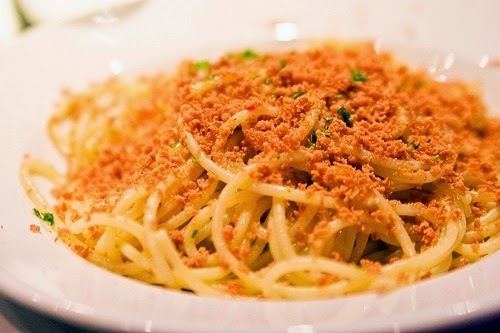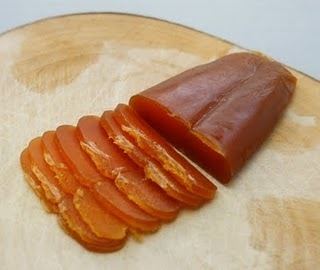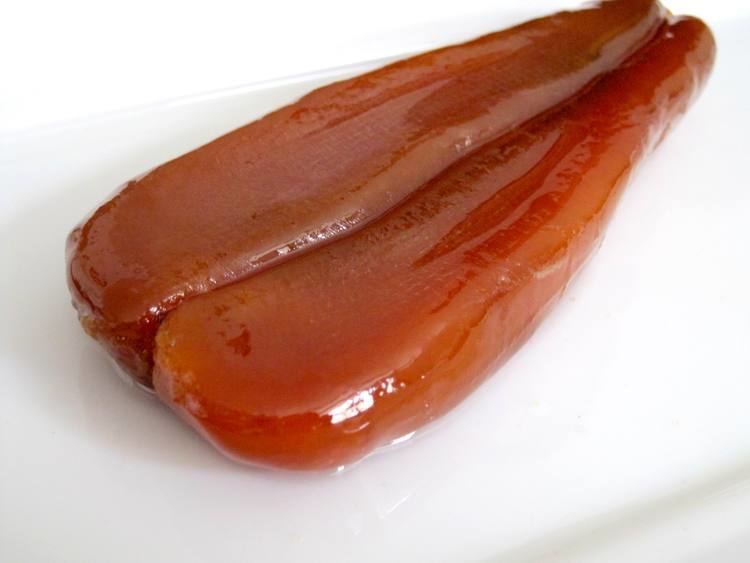 | ||
Alternative names Botarga, botargo, butàriga, and many others Similar Flathead grey mullet, Fregula, Karasumi, Spaghetti alle vongole, Roe | ||
Bottarga is the Italian name for a delicacy of salted, cured fish roe, typically of the grey mullet or the bluefin tuna (bottarga di tonno), frequently found near coastlines throughout the world, that often is featured in Mediterranean cuisine and consumed in many other regions of the world. The food bears many different names and is prepared in several different ways.
Contents
- Institucional bottarga gold
- Names and etymology
- Preparation
- Regions
- Croatia
- France
- Greece
- Italy
- Lebanon
- Africa
- Turkey
- Spain
- United States
- References
The product is similar to karasumi, the softer cured mullet roe from Japan and East Asia.
Institucional bottarga gold
Names and etymology

Closely related names are used for the delicacy in various languages: batarekh , butarkhah , batrakh (Arabic) or botarga (Occitan, Spanish, and Catalan). The name bottarga is used in English and Italian. In other languages it is called boutargue (French), butarga (Portuguese), and butàriga (Sardinian); avgotaraho (Greek αυγοτάραχο), abudaraho (Turkish) and poutargue (French). The Chinese name is 烏魚子.
The English name, bottarga, was borrowed from Italian. The Italian form is thought to have been introduced from the Arabic buṭarḫah بطارخة (plural buṭariḫ بطارخ), but ultimately derives from Byzantine Greek ᾠοτάριχον (oiotárikhon) < ᾠόν 'egg' + τάριχον 'pickled'.

The Italian form can be dated to ca. 1500, since the Greek form transliterated into Latin as ova tarycha occurs in Bartolomeo Platina's De Honesta Voluptate (ca. 1474), the earliest printed cookbook, and an Italian manuscript dating shortly afterward that "closely parallels" this cookbook attests to botarghe in the corresponding passage. The first mention of the Greek form (oiotárikhon) occurs in the eleventh century in the writings of Simeon Seth, who denounced the food as something to be "avoided totally", although a similar phrase may have been in use since antiquity in the same denotation.
It has been suggested that the Coptic outarakhon might be the intermediate form between Greek and Arabic, but this does not satisfactory explain how the "B" sound was introduced into the Arabic term buṭarḫah, whereas examination of dialectical variants of Greek ᾠόν 'egg' include Pontic Greek ὠβόν (traditionally where the mullets are caught) and ὀβό or βό in parts of Asia Minor, suggesting the Arabic was borrowed directly from these dialect forms. The modern Greek name comes from the Byzantine Greek, substituting the modern word αυγό for the ancient word ᾠóν.
Preparation
Bottarga is made chiefly from the roe pouch of grey mullet. Sometimes it is prepared from Atlantic bluefin tuna (bottarga di tonno rosso) or yellowfin tuna. It is massaged by hand to eliminate air pockets, then dried and cured in sea salt for a few weeks. The result is a hard, dry slab that sometimes is coated in beeswax for preservation purposes. Not all bottarga is coated in beeswax as some producers simply keep intact the natural casing of the roe, which contains the eggs securely once dried and salted. The curing time may vary depending on the producer and the desired texture as well as the preference of the consumers, which varies by country.
Regions
Sometimes called the caviar of the south, bottarga usually is sliced thinly or grated when it is served. The delicacy currently is served in many regions, including the following.
Croatia
In Croatia, the delicacy is known as butarga or butarda. It is usually fried before serving.
France
In the French region, Provence, it is named Poutargue and produced in the city of Martigues. It also may be called boutargue in France.
Greece
In Greece, avgotaraho is produced primarily from the flathead mullet caught in Greek lagoons. The whole mature ovaries are removed from the fish, washed with water, salted with natural sea salt, dried under the sun, and sealed in melted beeswax.
Avgotaraho Messolonghiou, made from fish caught in the Messolonghi-Etoliko Lagoons is a European and Greek protected designation of origin, one of the few seafood products with a PDO.
Italy
In Italy, it is best known in Sicilian and Sardinian cuisine as bottarga; its culinary properties may be compared to those of dry anchovies, although it is much more expensive. Often, it is served with olive oil or lemon juice as an appetizer accompanied by bread or crostini. It also is used in pasta dishes.
Bottarga is categorized as a Traditional food product (prodotto agroalimentare tradizionale). It varies by region, in particular, is produced in Sardinia from flathead mullet and in Sicily from Bluefin tuna.
Lebanon
In Lebanon it is served sliced, where each slice is covered with a piece of raw garlic and the whole is immersed in olive oil, then eaten with flat bread.
Africa
Bottarga is produced in Mauritania and Senegal.
Turkey
In Turkey, bottarga is made from grey mullet roe. It is listed in the Ark of Taste. It is produced in Dalyan, on the southwestern coast of Turkey, from the mature fish migrating from Lake Köyceğiz.
Spain
Bottarga in Spain is produced and consumed mainly in the country's sutheastern region, in the Autonomous Community of Murcia and the province of Alicante. It is usually made from a variety of roes including, among others, grey mullet, tuna, bonito, or even black drum or common ling (the latter two somehow cheaper and less valued). Much of its production is centered around the town of San Pedro del Pinatar, to the shores of the Mar Menor, where there are also salt ponds that are commercially exploited.
United States
The Anna Maria Fish Company in the Cortez Fishing Village located in Manatee County, Florida alongside a recently established and growing company named, "Gulf Coast Caviar" also located in Sarasota, Florida processes grey mullet roe into its bottarga that they sell locally, ship internationally, and make available to a few restaurants in the Gulf of Mexico region near Sarasota Bay. The county tourist bureau states that the process of making bottarga was depicted in Ancient Egyptian murals and that documentation from the 1500s exists that the Native Americans along the western coast of Florida were consuming dried mullet roe when encountered by European explorers.
Other locations in Florida also process bottarga.
